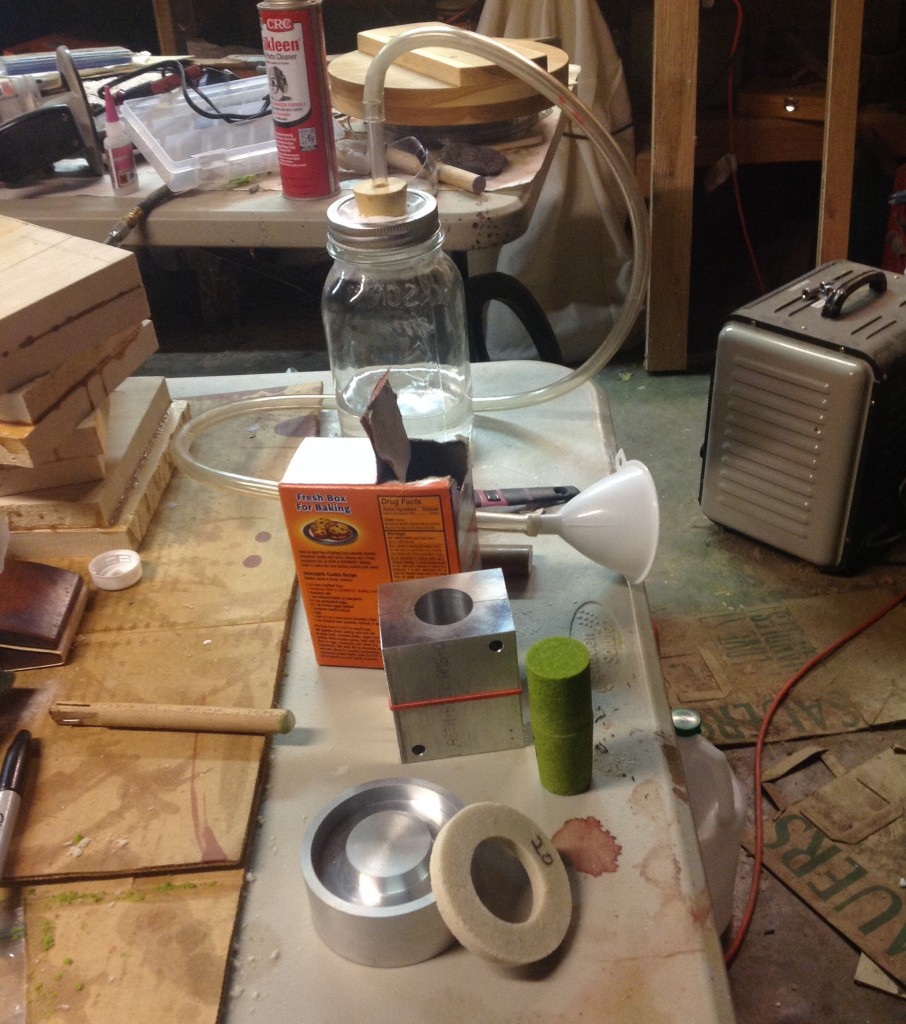In restoring a couple of late nineteenth century cider mills, I’ve had to reproduce a number of iron castings. To produce a hollow space, or a flange, as part of a casting, a hardened sand “core” is placed inside the mold cavity.
A mold that uses one or more cores is a “core mold” and the form used to produce the core is a “core box”. There are different types of cores, but the sodium silicate or “water glass” core sands were very common at one time, and are still used. You just need a source of CO2 to harden the sand, and you see my make-shift CO2 generator in the background. It uses soda and vinegar. It’s what I had on-hand.
The sand is mixed with about six percent by weight of sodium silicate, which acts as a binder. That makes a slightly “wet” sand that can be packed into the core box. Carbon dioxide is then pushed through the sand under pressure, it reacts with the sodium silicate and hardens it in seconds, resulting in what you might call a form of concrete. The now rigid core is placed in the sand mold, the mold is closed and the hot iron poured in. Once it cools the new part is shaken out of the sand, and the cores are readily broken out from inside the part.
In this case I’m making new bearings to support one of the rollers in the mill’s grinder box. I had a new restoration up and running last season, only to break that bearing because I’m an idiot and used an oak stick as a stomper to push some apples down into the machine. Oak; bad. It jammed the roller and the running, 40 pound flywheel popped the bearing in two. POW! We’ll see in a few days whether this new bearing works out.
Foundry is awesome.


Neat. I didn’t know about that recipe. There are others in the famous collection of home casting books by David Gingery, originally published by Lindsay Publications before that publisher closed down. I believe their collection was transferred to another publisher, though. Nice outfit: they reprinted a large and amazingly varied collection of old (copyright expired) technical books as well as some new original stuff. I have a few of the Gingery books (how to make a lathe and mill from scrap aluminum, cast in your backyard foundry). And a book on scraping. And a reprint of “Procedures in experimental physics” by John Strong, a great reference if you want to learn lab glass blowing, or mirror making, or how to make a Geiger tube, among other things.
I think Gingery describes core binding done with mundane stuff like molasses, but it’s been a while and I don’t remember the details.
Milling machine capable of producing iron parts of the size range in these machines; $50,000.00
Solid Works CAD software; I don’t recall but several thousand.
Home foundry setup; $600.00, and if you can make it out of wood or plastic, you can use it as a pattern for casting.
Then there is the fact that I’m restoring an antique, and that antique is built with cast iron. Therefore I want the new parts to be cast iron.
There are certain things you can do by hand MUCH faster and MUCH cheaper than doing it on a milling machine using CAD/CAM. Now if you want to make a million of something, all exactly alike, then take the extra time and expense up front for the technology, sure.
Here’s an example I’m sure we can all relate to. Say you have a pencil that needs sharpening. You could get on line and on the phone, and start calling machine tool companies, shopping for a table top milling machine, calling software companies and reading reviews to see what kind of CAD software you can afford, then fly out of state and rent a hotel room in order to take take a class to learn the basics of that software, and possibly check in to hiring someone to operate your milling machine, and so on and on and on. So rather than do all that you whip your knife out of your pocket and sharpen your pencil that way, and it’s done in less than one minute.
Now if you had a billion pencils to sharpen and a five or ten year time window in which to do it, with unlimited funds because some major war effort depends on it, sure; go the CAD/CAM route – that might make total sense.
Also you will notice that a lathe was used in making the core boxes. Lathes are not modem technology unless by “modern” you mean within the lest several thousand years. A potters wheel is a type of lathe, for example.
Again; the goal here is to make a part that’s just like the original. Antique restoration.
If I wanted a cider mill that simply worked, I’d go back on ar15.com to a thread from a few years ago, wherein a couple of guys built a cider mill out of wood, using a chainsaw. It seemed to have worked great too, so I’d set out to emulate that one.